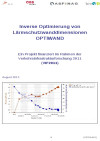OPTIWALL – Inverse optimization of noise barrier dimensioning
Short Description
Starting point / motivation
Planning of noise barriers for existing and new ASFINAG and ÖBB projects, as well as for street administration in Austrian federal states is based on defined guidelines (including recommendations, legal regulations and standards).
The aim of these regulations is to fulfil noise exposure limits taking into account technical and economic constraints. The current procedure is an iterative forward planning method, where height and length of noise barrier segments are stepwise varied until the planner detects an acceptable solution based on the given constraints.
The finally reached results depend on the experience and creativity of the individual planner. In general this iterative process is linked to an overestimation on the needed barrier area and/or is not using the full potential of the invested financial resources to protect the neighbours in the most optimal way.
Contents and goals
In this research project a method for inverse planning intended for the use as software solution is developed, which is adapted to the special Austrian regulations and especially matched for ASFINAG and ÖBB projects.
Inverse optimization minimizes individual weighted cost function consisting of barrier costs, violation of noise exposure limits, and additional constraints by modifying the barrier geometry. The mathematical algorithm takes into account the Austrian guidelines, standards, and legal regulations for street- and railway noise. The functionality was demonstrated with specific practical examples.
Methods
This method searched inversely the optimal noise barrier geometry based on a set of objectives. Such algorithms were currently used in different technologies and science e.g.:
- optimizing weights of components in aircraft design,
- radiotherapy and
- process optimization.
Within a research project funded by the Austrian Research Promotion Agency the basic requirements to use inverse optimization in noise control have been analysed.
In addition to the noise exposure limits also the costs for barriers, special protective windows, homogeneity of barrier heights and special designs were taken into account. Each constraint can be weighted by individual factors, which can be set to achieve reproducible results. Especially individual buildings or parts of buildings (e.g. upper floors) can be extracted, where the noise exposure could also be limited by sound insulating windows. Thus, the economic efficiency can be increased substantially.
Results and Conclusions
The results of this research project was
- the development of the mathematical basis for optimization based on Austrian regulations,
- the combination with existing experience in inverse planning for noise barriers and
- the development of a prototype to demonstrate the potential to plan the economical best, but also on the same side for the neighbours most optimal noise barrier solutions.
Publications
OPTIWALL - Inverse optimization of noise barrier dimensioning

This project developed a method to find the optimal solution for the planning of noise barriers regarding financial costs and effect.
Ao.Univ.-Prof. DI Dr. Christian Kirisits, Géza Horváth, Dr.-Ing. Ilias Sachpazidis, Dipl.-Ing. Thomas Drewes
Publisher: BMVIT
German, 87 Seiten
Publication Downloads
Project Partners
Project management
Dr. Christian Kirisits,ZT Büro Dr. Kirisits
Project partners
- Ing. Aikaterini Balta, PI-MEDICAL
- Dr. Klaus-Georg Krapf,Wölfel Meßsysteme Software GmbH + Co. KG
Contact Address
ZT Büro Dr. Kirisits
Dr. Christian Kirisits
Tel.: +43 (676) 353-52-49
E-mail: christian.kirisits@akustik-kiri.at
